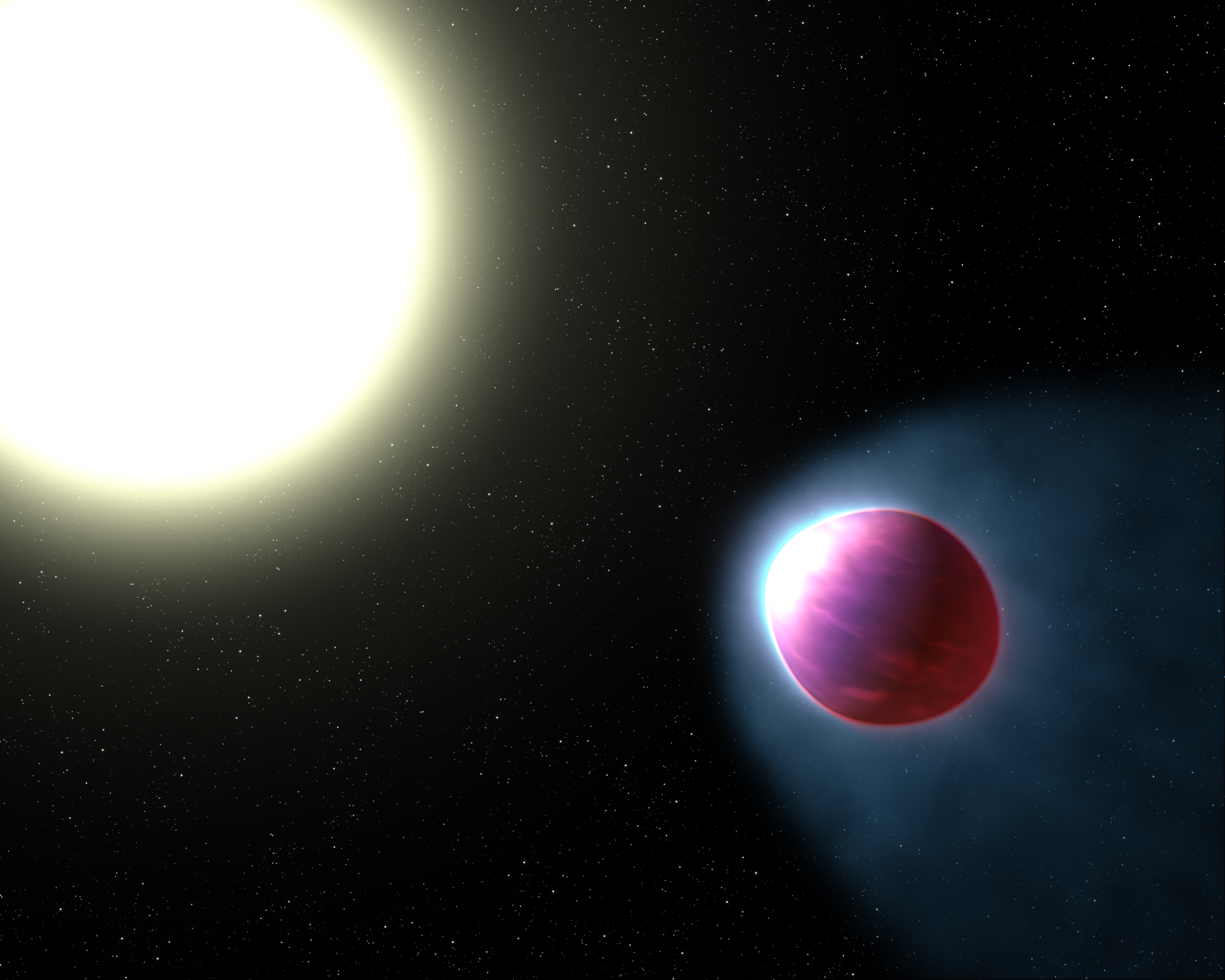Vaporised metal in the air of an exoplanet
An international team of researchers led by the National Centre of Competence in Research PlanetS of the University of Bern and the University of Geneva studied the atmosphere of the ultra-hot exoplanet WASP-121b. In it, they found a number of gaseous metals. The results are a next step in the search for potentially habitable worlds.
WASP-121b is an exoplanet located 850 light years from Earth, orbiting its star in less than two days - a process that takes Earth a year to complete. WASP-121b is very close to its star - about 40 times closer than Earth to the Sun. This close proximity is also the main reason for its immensely high temperature of around 2,500 to 3,000 degrees Celsius. This makes it an ideal object of study to learn more about ultra-hot worlds.
Researchers led by Jens Hoeijmakers, first author of the study and postdoctoral research fellow at the National Centre of Competence in Research PlanetS at the Universities of Bern and Geneva, examined data that had been collected by the high-resolution HARPS spectrograph. They were able to show that a total of at least seven gaseous metals occur in the atmosphere of WASP-121b. The results were recently published in the journal Astronomy & Astrophysics.
Unexpectedly much going on in the atmosphere of exoplanet WASP-121b
WASP-121b has been extensively studied since its discovery. "The earlier studies showed that there is a lot going on in its atmosphere," explains Jens Hoeijmakers. And this despite the fact that astronomers had assumed that ultra-hot planets have rather simple atmospheres because not many complex chemical compounds can form in such blistering heat. So how did WASP-121b come to have this unexpected complexity?
"Previous studies tried to explain these complex observations with theories that did not seem plausible to me," says Hoeijmakers. The studies had suspected that molecules containing the relatively rare metal vanadium were the main cause of the complex atmosphere in WASP-121b. According to Hoeijmakers, however, this would only make sense if a more common metal, titanium, were missing in the atmosphere. So Hoeijmakers and his colleagues set out to find another explanation. "But it turned out that they were right," admits Hoeijmakers unequivocally. "To my surprise, we actually found strong signatures of vanadium in the observations." At the same time, however, titanium was missing. This in turn confirmed Hoeijmakers' assumption.
Vaporised metals
But the team made other, unexpected discoveries. In addition to vanadium, they newly discovered six other metals in the atmosphere of WASP-121b: Iron, chromium, calcium, sodium, magnesium and nickel. "All metals evaporated as a result of the high temperatures prevailing on WASP-121b," explains Hoeijmakers, "thus ensuring that the air on the exoplanet consists of evaporated metals, among other things".
A new era in exoplanet research
Such detailed results allow researchers to draw conclusions about the chemical processes that take place on such planets, for example. This is a crucial skill for the not too distant future, when larger, more sensitive telescopes and spectrographs will be developed. These will allow astronomers to study the properties of smaller, cooler rocky planets similar to Earth. "With the same techniques we use today, instead of just detecting signatures of gaseous iron or vanadium, we will be able to focus on biosignatures, signs of life such as the signatures of water, oxygen and methane," says Hoeijmakers.
The extensive knowledge about the atmosphere of WASP- 121b not only confirms the ultra-hot character of the exoplanet, but also underlines the fact that this field of research is entering a new era, as Hoeijmakers puts it: "After years of cataloguing what is out there, we are now no longer just taking measurements," explains the researcher, "but we are really beginning to understand what the data from the instruments show us. How planets resemble and differ from each other. In the same way, perhaps, that Charles Darwin began to develop the theory of evolution after characterizing countless species of animals, we are beginning to understand more about how these exoplanets were formed and how they work".
Publication Details:H. J. Hoeijmakers et al.: Hot Exoplanet Atmospheres Resolved with Transit Spectroscopy (HEARTS) – IV. A spectral inventory of atoms and molecules in the high-resolution transmission spectrum of WASP-121 b, Astronomy & Astrophysics, 18.09.2020 DOI https://doi.org/10.1051/0004-6361/202038365 |
Exoplanetary research with the HARPS spectrographThe HARPS spectrograph is capable of detecting the faint light coming from distant planets with astonishing precision. Jens Hoeijmakers explains: "The atoms in the exoplanet's atmosphere each absorb part of the star's light. Each atom thus has a virtually unique fingerprint of the colours it absorbs". These fingerprints can be measured with a sensitive spectrograph such as HARPS and the chemical composition of the exoplanet's atmosphere can be derived from them, even if they are many light years away. The HARPS spectrograph was developed under the leadership of the Geneva Observatory by a consortium that also included the Observatoire de Haute-Provence, the Physics Institute of the University of Bern and the Service d'Aéronomie, Paris. More information about HARPS: https://www.unige.ch/sciences/astro/exoplanets/en/projects/harps |
Bernese space exploration: With the world’s elite since the first moon landingWhen the second man, "Buzz" Aldrin, stepped out of the lunar module on July 21, 1969, the first task he did was to set up the Bernese Solar Wind Composition experiment (SWC) also known as the “solar sail” by planting it in the ground of the moon, even before the American flag. This experiment, which was planned and the results analysed by Prof. Dr. Johannes Geiss and his team from the Physics Institute of the University of Bern, was the first great highlight in the history of Bernese space exploration Ever since Bernese space exploration has been among the world’s elite. The numbers are impressive: 25 times were instruments flown into the upper atmosphere and ionosphere using rockets (1967-1993), 9 times into the stratosphere with balloon flights (1991-2008), over 30 instruments were flown on space probes, and with CHEOPS the University of Bern shares responsibility with ESA for a whole mission. The successful work of the Department of Space Research and Planetary Sciences (WP) from the Physics Institute of the University of Bern was consolidated by the foundation of a university competence center, the Center for Space and Habitability (CSH). The Swiss National Fund also awarded the University of Bern the National Center of Competence in Research (NCCR) PlanetS, which it manages together with the University of Geneva. |
Exoplanet research in Geneva: 25 years of expertise awarded a Nobel PrizeCHEOPS will provide crucial information on the size, shape, formation and evolution of known exoplanets. The installation of the "Science Operation Center" of the CHEOPS mission in Geneva, under the supervision of two professors from the UniGE Astronomy Department, is a logical continuation of the history of research in the field of exoplanets, since it is here that the first was discovered in 1995 by Michel Mayor and Didier Queloz, winners of the 2019 Nobel Prize in Physics. This discovery has enabled the Astronomy Department of the University of Geneva to be at the forefront of research in the field, with the construction and installation of HARPS on the ESO's 3.6m telescope at La Silla in 2003, a spectrograph that remained the most efficient in the world for two decades to determine the mass of exoplanets. However, this year HARPS was surpassed by ESPRESSO, another spectrograph built in Geneva and installed on the VLT in Paranal. CHEOPS is therefore the result of two national expertises, on the one hand the space know-how of the University of Bern with the collaboration of its Geneva counterpart and on the other hand the ground experience of the University of Geneva supported by its colleague in the Swiss capital. Two scientific and technical competences that have also made it possible to create the National Center of Competence in Research (NCCR) PlanetS. |
2020/10/08


